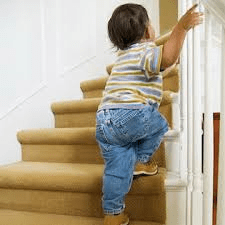Child Development of Self-Care Skills
By Jessica Holyoke, OTR-L
Kids Place Pediatric Occupational Therapist
Activities of daily living (ADLs) are a necessary part of our day and include various tasks such as getting dressed, bathing, brushing our teeth or hair, and feeding ourselves. Most of us place very little thought or effort when carrying out these tasks, but how did we learn to perform them? Throughout the first year of our life, we will begin to develop the skills necessary to take care of ourselves. It is important that children have many opportunities to practice these skills. This blog will look at the typical development of these self-care skills and give examples of how to encourage your child’s development.
Dressing
A 1 year old child has already begun to explore how to take off clothes by removing their socks and raising their arms to help get a shirt off. Between 1 and 2 years old, your child will continue this exploration and learn to take off his or her shoes and socks. They will also begin to help put their arms through holes and hold out their legs for pants. Between the ages of 2 and 3 years, a child can remove simple clothing on their own. They are learning to put on front closing tops (jackets, button-up shirts) and to unzip and unbutton large buttons. By 4 years old, a child can dress and undress themselves with assistance for fasteners and ties. By 5 or 6 years old, a child is nearly independent with dressing skills needing help only with difficult fasteners such as belts and selecting appropriate clothing to match the weather.
Bathing & Grooming
A 1 year old child is starting to become aware of cleaning themselves. They can wipe their face with a napkin or towel (not completely). They can grasp tools such as a toothbrush or spoon, and mimic movements that will develop into controlled use. Between 1 and 2 years, a child begins to enjoy bathing and takes an interest in helping. By 3 years, they are actively participating in washing and helping with brushing teeth. At 3 or 4 years, a child can wash themselves with supervision and some help with hair. A 5 to 6 years child should be able to complete bathing and grooming tasks on their own with occasional reminders to do a thorough job.
Toileting
When to potty train can often be confusing for parents. Typically, the first indication that a child is ready to start potty training is their ability to indicate when they are wet or soiled, which typically occurs by age 2. The next step is their ability to indicate needing to go to the bathroom. A 3 year old child should be using the bathroom with daytime control, still needing help for wiping and managing clothing. By 4 years old, a child develops nighttime control and needs less help with wiping and managing fasteners on clothing. At 5 or 6 years, a child is independent with toileting tasks.
Feeding
Around 6 months, a child develops the upper body and hand strength to hold their own bottle. By 7-8 months, they can grasp small pieces of cereal or baby cookies and bring it to their mouth. They may start using a spoon for feeding by about 12 months. Between 1-2 years, a child is using a spoon (with spilling) and can hold and drink from a Sippy Cup. Between 2 and 5 years, a child develops the ability to use a spoon and fork, and can drink from a cup with no lid (with some spilling).
The most important thing to remember about any skill development in childhood is that is takes time and lots of practice. Spend time on these skills, especially in the evenings and weekends when there is a bit more time to spare. Give as little help as possible. As the child gets older, allow them to work through problems and give more verbal feedback than hands on help. Children learn through play so turn it into a game. You can play dress-up or dress a stuffed animal for dressing skills, play peek-a-boo games where the child pulls a napkin or washcloth off their face or head for grooming skills, and use spoons and other utensils while playing in pudding or applesauce for feeding and utensil use. Give your child as many opportunities as possible to practice their skills, let them make mistakes, and have fun learning new skills.
It is important to remember that these skills develop at a different pace for each child and the ages presented are considered average. If your child develops these skills slightly faster or slower, there is no need for alarm. If there is a significant delay in the development of these skills, your child may benefit from an occupational therapy evaluation. Please feel free to leave your comments in the section below if you have specific questions regarding your child.







